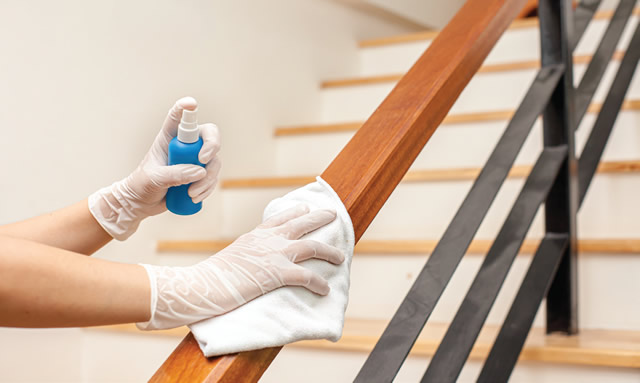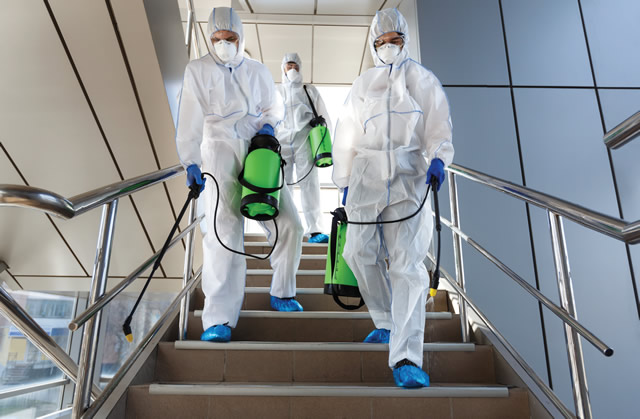Pandemic Response: Protecting Custodial Workers
- By Eugene C. Cole
- 03/01/20
Custodial personnel
work diligently to achieve and
maintain clean and healthful
indoor environments. Whether
in schools or office buildings,
their efforts help to reduce
reservoirs of biological, chemical,
and particulate pollutants
associated with dust and
soil deposits on surfaces and
in carpeting from becoming
sources that can affect the
quality of the indoor air. They
remove waste, clean and polish
floors, and engage in a variety
of chores that increases their
physical risk, such as working
with chemicals and performing
heavy lifting.

Photo © Nitiphonphat
Yet, as custodial personnel
work regularly to protect the
built environment and prevent
undue occupant exposures, we must recognize their need to also
be adequately protected during a pandemic outbreak. And this
protection can only come from their recognition of the risks
and hazards associated with their work during a pandemic, and
the need for them to be actively involved in the development of
modified cleaning practices and behaviors that will help reduce
infectious disease risks, not only for a building’s occupants, but
especially for themselves. Their input is invaluable to ensuring
that new and modified practices during the pandemic are feasible
and efficient.
In that regard, the following are specific action items for custodial
personnel to consider in protecting themselves, as they
work to protect all occupants of the building for which they
have responsibility to maintain.
1. Understand the infectious agent, how it’s transmitted, the
seriousness of the disease it causes, and the symptoms that indicate
infection.
2. Identify surfaces considered to be high contact touch
points associated with hand contamination and risk of infection
transmission. These typically include desktops, table tops, countertops,
chair armrests, draw and cabinet pulls, appliance handles
and doors (microwaves, refrigerators), copy machines, elevator
buttons, key card devices, door handles, knobs, and breaker
bars, all exterior vending machine surfaces, and water coolers
and fountains.
3. Ensure the supply and proper use of basic, disposable personal
protective equipment (PPE), to include gloves and face
mask (N95). Disposable coveralls should also be available for use when cleaning and disinfecting surfaces, to especially include
restrooms, which are considered high risk. Coveralls will
minimize the transport of contamination
from the workplace to home
and family.
4. Facilitate the cleaning of high
contact surfaces using an EPA-approved
one-step cleaner/ disinfectant.
The product should be sprayed on a
disposable cloth or towel and then
used to clean, changing the cloth frequently
to avoid cross-contamination
of surfaces. During a pandemic, the
cleaning of high contact touch points
at an increased frequency is much
more important than frequent floor
cleaning.
5. Ensure that occupants of the facility, whether teachers in
classrooms, or administrators in offices, are supplied with hand
sanitizer and disinfectant wipes. The use of those wipes will
help them keep their own personal spaces and work surfaces
clean, as necessary, and reduce the
risk of contamination transmission.
In schools, classrooms with hand
sanitizer will encourage students to
use it, as well as remember to wash
hands too. Custodians can’t do it all,
and occupants with their own offices
have an inherent responsibility to
help protect themselves.
6. Close off areas where high risk
incidents have occurred, such as vomiting
or bleeding, and report them to
management for awareness and initiation
of a previously developed hazard
remediation protocol.
7. Ensure that cleaning equipment is maintained and cleaned
properly to reduce the risk of spreading contamination.
8. Engage in frequent
hand washing, especially
when removing
gloves and coveralls, and
be mindful to not store or
eat food in custodial rooms
or closets.
9. Notify management
immediately if symptoms
of illness are noticed.
Cleaning is a systematic,
science-based process
of managing unwanted
matter, so human activities
can take place in a
healthy environment. And
when targeted cleaning is
implemented under threat
of a pandemic, or in the
throes of one, it results in
a protective risk reduction
for all those in office buildings,
as well as teachers,
students and staff in school
environments. For schools
in particular, recent studies
have collectively indicated
that enhanced hygiene
in schools, with targeted
cleaning of biological residual
contamination related
to frequent-contact
points, resulted in reduced
illnesses tied to bacterial
contamination reservoirs,
reduced sick building syndrome symptoms, and reduced absenteeism
due to infectious illnesses.

Photo © Prostock-studio
Protocols for such control practices should be developed with
input from facility managers and all custodial personnel to ensure
that the switch to enhanced hygiene efforts can be managed
with existing custodial personnel, supplies, and equipment.
The emphasis thus focuses on cleaning for health rather
than appearance, whereby designated surfaces are prioritized for
cleaning and disinfection, above others recognized as of lesser
importance relative to disease transmission.
Lastly, in the event of a pending or existing pandemic, increased
pressure will be brought upon custodial personnel, due
to the heightened demands of enhanced hygiene practices and
risk reduction. Facing changes in work behavior and schedules
amidst the demands, custodians can be hit with an unexpected
burden of mental stress. Supervisors need to be aware of and
strive to preempt such conditions by quickly addressing custodial
problems and concerns as soon as they arise, and ensuring
that all custodians receive the support and appreciation they
deserve as dedicated keepers of a healthy indoor environment.
References:
Berry, MA (2018). “Cleaning professionalism and competent
management”; Cleaning Science Quarterly 1(1):8–12.
Higashiyama, M, Ito, T, Han, X, , PhD, Nishiyama, J, Tanno,
A, Wada, T, Funaoka, MT, Yoshida, Y, Mikita, K, Ogawa, T,
Okusa, Y, Kaku, K, Hatada, J, Hiramatsu, K, & Kawana, A
(2011). “Trial to control an outbreak of Panton-Valentine leukocidin–positive methicillin-resistant Staphylococcus aureus
at a boarding school in Japan”; American Journal of Infection
Control, 39:858 – 865.
Hostetler, K, Lux, M, Shelley, K, Drummond, J, & Laguna,
P (2011). “MRSA as a health concern in athletic facilities”;
Journal of Environmental Health, 74:18–25.
Zhang, X, Zhao, Z, Nordquist, T, Larsson, L, Sebastian, A, & Norback, D (2011). “A longitudinal study of sick building
syndrome among pupils in relation to microbial components
in dust in schools in China”; Science of the Total Environment,
409:5253–5259.
Schulte, J, Williams, L, Jawaid, A, Dang, T, Bedwell, S,
Guerrero, K, Hamaker, D, Stonecipher, S, Zoretic, J, & Chow,
C (2012). “How we didn’t clean up until we washed our hands:
Shigellosis in an elementary and middle school in North Texas”;
Southern Medical Journal, 105:1 – 4.
This article originally appeared in the March/April 2020 issue of Spaces4Learning.